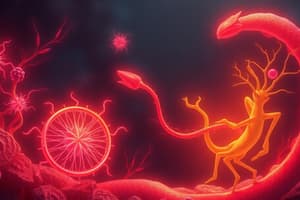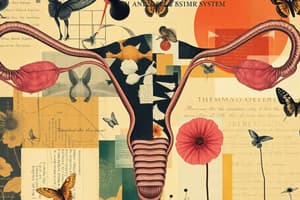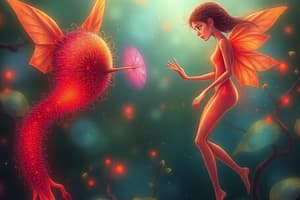Podcast
Questions and Answers
How does reproduction ensure the continuity of a species?
How does reproduction ensure the continuity of a species?
By passing on genes and ensuring genetic diversity through offspring.
What are the two main types of reproduction?
What are the two main types of reproduction?
Asexual and sexual reproduction.
What is a characteristic of asexual reproduction?
What is a characteristic of asexual reproduction?
- Requires fertilization
- Involves only one parent (correct)
- Produces genetically diverse offspring
- Involves two parents
Which of the following is NOT an advantage of asexual reproduction?
Which of the following is NOT an advantage of asexual reproduction?
Match the following types of reproduction with their definitions:
Match the following types of reproduction with their definitions:
Do offspring produced by asexual reproduction have genetic variation?
Do offspring produced by asexual reproduction have genetic variation?
What is the process by which gametes are produced in sexual reproduction?
What is the process by which gametes are produced in sexual reproduction?
What is internal fertilization?
What is internal fertilization?
Which of the following is an advantage of sexual reproduction?
Which of the following is an advantage of sexual reproduction?
Which of the following is a disadvantage of asexual reproduction?
Which of the following is a disadvantage of asexual reproduction?
The process of meiosis results in cells that are __________.
The process of meiosis results in cells that are __________.
What type of fertilization is commonly seen in aquatic environments?
What type of fertilization is commonly seen in aquatic environments?
What role does oxytocin play during labor?
What role does oxytocin play during labor?
Which hormones work in partnership during pregnancy?
Which hormones work in partnership during pregnancy?
A gene is a segment of DNA that specifies a particular _______.
A gene is a segment of DNA that specifies a particular _______.
Mitosis produces four daughter cells.
Mitosis produces four daughter cells.
What is the difference between diploid and haploid cells?
What is the difference between diploid and haploid cells?
What is the role of crossing over in meiosis?
What is the role of crossing over in meiosis?
Match the following terms with their definitions.
Match the following terms with their definitions.
What happens during DNA replication?
What happens during DNA replication?
Independent assortment occurs during anaphase of meiosis.
Independent assortment occurs during anaphase of meiosis.
What is the significance of DNA replication?
What is the significance of DNA replication?
What structures are used for sexual reproduction in seed-producing plants?
What structures are used for sexual reproduction in seed-producing plants?
What is formed after fertilization in flowering plants?
What is formed after fertilization in flowering plants?
What changes occur in the ovary after fertilization?
What changes occur in the ovary after fertilization?
What are the advantages of spores in fungi?
What are the advantages of spores in fungi?
Seeds are unicellular.
Seeds are unicellular.
What is binary fission?
What is binary fission?
Which group of mammals gives birth to developed live young?
Which group of mammals gives birth to developed live young?
The fertilization occurs in the _____ tube.
The fertilization occurs in the _____ tube.
What is the role of testosterone in the male reproductive system?
What is the role of testosterone in the male reproductive system?
What is the main function of the placenta in placental mammals?
What is the main function of the placenta in placental mammals?
The cervix stretches to allow the passage of a baby during childbirth.
The cervix stretches to allow the passage of a baby during childbirth.
What triggers ovulation in females?
What triggers ovulation in females?
The male reproductive organ that delivers urine or semen out of the body is called the _____
The male reproductive organ that delivers urine or semen out of the body is called the _____
What pushes semen from the urethra into the vagina during muscular contractions?
What pushes semen from the urethra into the vagina during muscular contractions?
How long can sperm survive within the female reproductive tract?
How long can sperm survive within the female reproductive tract?
What is the ball of undifferentiated cells formed after fertilisation called?
What is the ball of undifferentiated cells formed after fertilisation called?
What does the morula develop into as it continues to move down the oviduct?
What does the morula develop into as it continues to move down the oviduct?
When does implantation typically occur after fertilisation?
When does implantation typically occur after fertilisation?
What forms from the outer layer of cells in the blastocyst?
What forms from the outer layer of cells in the blastocyst?
What is the primary function of the placenta during pregnancy?
What is the primary function of the placenta during pregnancy?
From which structure does the umbilical cord develop?
From which structure does the umbilical cord develop?
The blood of the mother and fetus mix during pregnancy.
The blood of the mother and fetus mix during pregnancy.
How are gases and nutrients exchanged between the mother and fetus?
How are gases and nutrients exchanged between the mother and fetus?
What marks the beginning of the foetus stage?
What marks the beginning of the foetus stage?
The three primary layers of the gastrula are ectoderm, mesoderm, and ______.
The three primary layers of the gastrula are ectoderm, mesoderm, and ______.
What hormone is produced by the developing embryo during the first trimester?
What hormone is produced by the developing embryo during the first trimester?
What effect does oestrogen have during pregnancy?
What effect does oestrogen have during pregnancy?
Which hormone is primarily responsible for initiating labor?
Which hormone is primarily responsible for initiating labor?
What is the function of relaxin during pregnancy?
What is the function of relaxin during pregnancy?
During which phase does DNA replication occur?
During which phase does DNA replication occur?
What is the role of mRNA in protein synthesis?
What is the role of mRNA in protein synthesis?
Which codon is known as the start codon?
Which codon is known as the start codon?
Centromeres are responsible for the movement of chromosomes during cell division.
Centromeres are responsible for the movement of chromosomes during cell division.
What does tRNA attach to in order to assist in translation?
What does tRNA attach to in order to assist in translation?
What are the two types of mutations mentioned?
What are the two types of mutations mentioned?
What is the primary role of DNA mismatch repair?
What is the primary role of DNA mismatch repair?
Stop codons code for amino acids.
Stop codons code for amino acids.
The ______ is a polymer of many amino acids linked by peptide bonds.
The ______ is a polymer of many amino acids linked by peptide bonds.
What is the importance of accurate DNA replication?
What is the importance of accurate DNA replication?
What can affect the phenotypic expression of an organism?
What can affect the phenotypic expression of an organism?
What do mutagens refer to?
What do mutagens refer to?
Which of the following statements about mutations is true?
Which of the following statements about mutations is true?
The strands of DNA in eukaryotes are __________, while in prokaryotes they are __________.
The strands of DNA in eukaryotes are __________, while in prokaryotes they are __________.
Match the following processes with their descriptions:
Match the following processes with their descriptions:
Where is the genetic code found in prokaryotic cells?
Where is the genetic code found in prokaryotic cells?
What is the role of tRNA in protein synthesis?
What is the role of tRNA in protein synthesis?
What is the function of ribosomes?
What is the function of ribosomes?
Match the following types of RNA with their roles.
Match the following types of RNA with their roles.
Study Notes
Reproduction Overview
- Reproduction is the process by which organisms produce offspring, ensuring continuity of species.
Asexual Reproduction
- Involves a single parent, producing genetically identical offspring.
- Key process is mitosis; no gametes are involved.
- Types include:
- Parthenogenesis: Development from an unfertilized egg, as seen in certain reptiles and plants (e.g., brambles, dandelions).
- Advantages: No need for males or pollinators.
- Disadvantage: Lack of genetic diversity.
- Regeneration: Parent organism splits and regenerates into new individuals.
- Example: Planarians.
- Fragmentation: Body breaks into pieces, with each piece developing into a new organism.
- Example: Sponges, flatworms.
- Advantage: Retained stem cells for regeneration, allowing for regrowth and reproduction.
- Parthenogenesis: Development from an unfertilized egg, as seen in certain reptiles and plants (e.g., brambles, dandelions).
Sexual Reproduction
- Involves two parents, producing genetically diverse offspring through the combination of their genes.
- Key differences from asexual reproduction:
- Genetic variation due to gamete combination.
- Slower process requiring energy for finding mates and nurturing offspring.
Comparison of Reproductive Methods
-
Asexual Advantages:
- Rapid population increase.
- No mate searching required.
- Ideal in stable environments.
-
Asexual Disadvantages:
- Low genetic variation, risking population decline in changing environments.
-
Sexual Advantages:
- High genetic variation enhancing adaptability.
- Natural selection favors stronger offspring.
-
Sexual Disadvantages:
- Higher energy expenditure for finding mates and parental care.
Fertilization Types
- External Fertilization:
- Large numbers of gametes released in open water.
- Typically lower fertilization success.
- Vulnerable zygote environment.
- Internal Fertilization:
- Male gametes fertilize eggs inside the female.
- Higher success due to close proximity and protected development.
- More parental care typically involved.
Fertilization Process in Animals
- Gametes produced by gonads through meiosis.
- Somatic cells are diploid (2n), while gametes are haploid (n).
- Zygote formation returns to diploid status.
- Life stages alternate between haploid and diploid generations.
Plant Reproduction
-
Asexual Reproduction in Plants:
- Vegetative Propagation: New plants arise from roots, stems, leaves; examples include strawberries and potatoes.
- Advantages and disadvantages in resource competition and genetic variation highlighted.
-
Sexual Reproduction in Plants:
- Involves seed cones (gymnosperms) or flowers (angiosperms).
- Pollination and Fertilization Steps:
- Pollen grain lands on stigma and creates a tube toward the ovary.
- Male gametes fertilize an ovule to form a diploid zygote and triploid endosperm.
- Seeds develop within a protective fruit.
Summary
- Reproduction, both sexual and asexual, is vital for species continuity, adapting to environmental changes through genetic variation, and maintaining population stability through efficient reproductive strategies.### Seed Germination and Dispersal
- Seeds germinate when conditions are suitable, developing into new plants.
- Ovules develop into seeds protected by a seed coat; the zygote becomes a multicellular embryo.
- The embryo forms cotyledons, root tips, and vascular tissues.
- The ovary matures into fruit, which protects seeds and aids in their dispersal.
Seed Dispersal Importance
- Dispersal minimizes competition for resources like light, water, and nutrients.
- Fruits can be dry (e.g., banksia pods) or fleshy (e.g., apples).
- Dry fruits may have explosive mechanisms for dispersal; light seeds can float on air or water.
- Fleshy fruits rely on animals for dispersal—animals consume the fruit, excreting seeds elsewhere.
Seeds vs Spores
- Seeds are multicellular with mechanisms for survival; found in flowering plants.
- Spores are unicellular with limited survival facilities; found in non-flowering plants.
Pollination Types
- Wind-pollinated flowers: small, inconspicuous petals; abundant lightweight pollen for wind dispersal.
- Bird-pollinated flowers: large, colorful petals; produce nectar; attract through visual and olfactory cues.
- Insect-pollinated flowers: large, often fragrant petals; produce nectar to attract insects.
Germination and Dormancy
- Dormant seeds remain inactive until hydrated and environmental conditions are favorable.
- Essential factors include water, oxygen, temperature, and daylight.
Fungi Reproduction: Budding and Spores
- Budding involves a small bud forming from the parent, leading to new individuals.
- Advantages of budding include rapid reproduction and no need for another organism.
- Disadvantages include genetic mutation and reduced diversity.
- Spores are unicellular, lightweight, and enable rapid expansion, though survival rates are low.
Bacterial Reproduction: Binary Fission
- Common in prokaryotes; the cell divides into two equal daughter cells.
- Advantages include rapid replication and independence in reproduction.
- Disadvantages include genetic mutations leading to reduced diversity.
Mammalian Reproduction Overview
- Placental mammals have a uterus providing nourishment via the placenta and umbilical cord.
- Marsupials give birth to underdeveloped young, which develop in external pouches.
- Monotremes lay eggs and feed young with milk after hatching.
Male Reproductive System
- Testes in the scrotum produce and store sperm; key structures include seminiferous tubules and epididymis.
- Accessory glands produce seminal fluid rich in nutrients to aid sperm motility.
- Hormones such as testosterone and gonadotropins regulate sperm production and reproductive functions.
Female Reproductive System
- The uterus is where fertilized eggs implant and develop.
- Ovaries store oocytes; fallopian tubes are the site of fertilization.
- The menstrual cycle involves hormonal regulation affecting egg maturation, uterine lining preparation, and menstruation.
Fertilization and Implantation
- Fertilization occurs when haploid gametes form a diploid zygote in the fallopian tube.
- Implantation of the blastocyst occurs around 8-9 days post-fertilization in the uterine wall.
Placenta and Umbilical Cord Functionality
- The placenta serves as an exchange organ, allowing nutrient and waste transfer without mixing maternal and fetal blood.
- The umbilical cord develops to connect the embryo to the placenta for nutrient delivery.
Pregnancy Stages
- Pregnancy is calculated from the last menstrual period; embryo stage lasts from implantation to 9 weeks.
- Major organ development occurs during the embryonic stage, completing by 8 weeks post-fertilization.
Germ Layers in Embryonic Development
- Gastrulation results in ectoderm (nervous system, skin), mesoderm (muscle, kidney), and endoderm (digestive and respiratory systems).
Hormonal Control in Female Reproductive Cycle
- Oestrogens regulate female reproductive functions and secondary characteristics.
- The cycle involves ovulation, fertilization, and preparation of the uterus for potential pregnancy.### Development of the Foetus
- The term "foetus" is used from 9 weeks after fertilisation until 38 weeks.
- During this period, the foetus grows and develops organs.
- Cells and tissues specialise to perform their specific functions.
- The foetus is safeguarded within the amniotic cavity, a fluid-filled environment.
Hormones in Pregnancy
-
Human Chorionic Gonadotropin (hCG)
- Produced by the developing embryo and later by the placenta.
- Maintains the corpus luteum, which secretes progesterone and oestrogen.
- hCG levels decline after 12 weeks as the corpus luteum deteriorates.
- Detected in urine for pregnancy tests.
-
Oestrogen
- Initially produced by the corpus luteum; later the placenta and adrenal glands.
- Suppresses GnRH, FSH, and LH to prevent ovulation and menstruation.
- Rising levels during pregnancy support its maintenance.
- Induces receptors on the uterus for oxytocin in the third trimester, facilitating labour.
-
Progesterone
- Main hormone of pregnancy, produced by the corpus luteum and later by the placenta.
- Maintains the endometrium and inhibits ovulation.
- Promotes physical changes in the mother, including uterine enlargement and breast growth.
- Levels rise throughout pregnancy to inhibit contractions.
-
Relaxin
- Released by the corpus luteum and placenta during pregnancy, and by ovaries during birth.
- Relaxes maternal joints and tissues to accommodate the growing foetus.
- Facilitates cervical dilation during parturition.
-
Prolactin
- Produced by the pituitary gland, increasing in the second trimester.
- Stimulates milk production in mammary glands.
Hormones in Birth (Parturition)
-
Oestrogen
- Increases sensitivity of the uterus to oxytocin, promoting contractions.
- Reduces effects of progesterone that suppress contractions.
-
Oxytocin
- Secreted by the pituitary gland, critical for initiating and maintaining labour.
- Triggers uterine contractions and facilitates the release of prostaglandins.
-
Prostaglandin
- Produced by the uterine wall, aids in initiating labour and stimulating contractions.
-
Relaxin
- Facilitates the dilation of the cervix and relaxation of pelvic ligaments.
-
Cortisol
- Released from the foetus and uterus, increases oestrogen levels and decreases progesterone.
Importance of Hormonal Balance
- A correct hormonal balance is vital for sustaining pregnancy.
- Increased prostaglandins heighten responsiveness to oxytocin, leading to labour.
- After childbirth, oxytocin aids in uterine contractions to deliver the placenta and reduces uterus size.
Genetic Material and Cell Replication
- Genes are hereditary units located on chromosomes; humans have two copies of each autosomal gene.
- Alleles are variations of genes that determine specific traits, such as height or seed colour.
- Diploid individuals possess two alleles; haploid cells have one.
Mitosis
- Mitosis comprises four phases:
- Prophase: Chromosomes condense and the nucleolus disappears.
- Metaphase: Chromosomes align at the cell's equator.
- Anaphase: Sister chromatids separate and move to opposite poles.
- Telophase: Nuclei reform, concluding nuclear division.
- Cytokinesis follows, splitting the cytoplasm into two daughter cells.
Meiosis
- Meiosis creates haploid gametes and promotes genetic diversity.
- Essential for sexual reproduction, ensuring offspring inherit characteristics from both parents.
Studying That Suits You
Use AI to generate personalized quizzes and flashcards to suit your learning preferences.
Related Documents
Description
Explore how reproduction ensures the continuity of species through various mechanisms. This quiz analyzes both sexual and asexual reproduction methods across different organisms, highlighting their significance in biodiversity and species survival.




